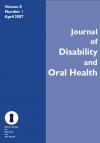Journal of Disability and Oral Health

- Cover Date:
- April 2007
- Print ISSN:
- 1470-8558
- Electronic ISSN:
- 1754-2758
- Vol:
- 8
- Issue:
- 1
Assessment of malocclusion and orthodontic treatment need in disabled children in Nigeria
Objective: To compare the prevalence of malocclusion and orthodontic treatment needs of three major groups with disabilities in Lagos, Nigeria using the Dental Aesthetic Index (DAI). Methods: The s t u d y sample consisted of 428 disabled children (114 intellectually disabled, 253 with hearing impairments, 61 physically disabled) aged 6–18 years randomly selected from five special schools/ centres in Lagos. Results: Dental appearance which required no orthodontic treatment or slight need accounted for 65.7% of the sample. Just over 17% had a definite malocclusion where treatment was ‘elective’; 9.3% had a severe malocclusion with treatment ‘highly desirable’ and 7.7% had a severe or handicapping malocclusion with treatment considered mandatory. The intellectually disabled group presented the highest mean DAI score (p< 0.001). In addition, there were statistically significant differences between the disabled groups in all the categories of orthodontic treatment needs according to the DAI. There was a statistically significant association between severity of malocclusion and type of disability (p< 0.001). The prevalence of severe and handicapping malocclusions was significantly higher in the intellectually disabled children. Significant differences were found in certain malocclusion traits between the groups. The intellectually disabled children had a significantly higher prevalence of missing teeth, anterior maxillary irregularity, anterior open bite and molar relationship discrepancies when compared to the other disabled groups. Conclusion: Significant differences in mean DAI scores (p < 0.001) were found between the disabled groups with the intellectually disabled group presenting the highest mean DAI score. The significantly higher differences in the intellectually disabled children could qualify them for publicly subsidised orthodontic care. Key words: Disabled children, orthodontic treatment need, DAI, Nigeria
- Article Price
- £15.00
- Institution Article Price
- £15.00
- Page Start
- 3
- Page End
- 8
- Authors
- I L Utomi, C O Onyeaso
Articles from this issue
- Title
- Pg. Start
- Pg. End
- An analysis of the pattern of dental treatment provided for patients with disabilities requiring treatment under general anaesthesia
- 9
- 12
- A longitudinal study of palatal plate therapy in children with Down syndrome. Effects on oral motor function
- 13
- 19
- Dyslexia and errors of left-right discrimination in undergraduate dental and postgraduate orthodontic students
- 23
- 27
- Delayed replantation of avulsed incisors in a child with cerebral palsy and epilepsy – a case report
- 31
- 33
- Using large numbers can overwhelm efforts to secure care for children with special health care needs. A case study in the USA
- 34
- 36
- Preparing a child with autism for dental prophylaxis using structured and instructional methods: a case report
- 45
- 47
